
Italy 4.0 Pursuing the digital future amid macro-gloom
20 minute read
18 January 2019
Italy is leading in many aspects of the Fourth Industrial Revolution. But weaknesses in infrastructure and education contribute to a cautious mood as executives grapple with making the digital future a reality.
At present, Italy preoccupies both the EU and financial markets. There are unquestionably serious economic concerns. However, within the 28 EU member states, Italy is the second-largest manufacturer, behind Germany.1 And as revealed by our survey of around 100 Italian executives, which builds on Deloitte Global’s survey of 19 leading Asian, European and American countries, Italy is at the global forefront in many aspects of the Fourth Industrial Revolution, the digital revolution.2
Learn more
Read the full Italian report: Italia 4.0: siamo pronti?
Explore the Industry 4.0 collection
Subscribe to receive updates on Industry 4.0
What also emerges strongly from the survey is that Italian executives fully appreciate digitalisation is fundamental to their companies’ futures and are looking to adopt and use digital technologies. A strong industrial base and awareness of the potential of digitalisation means Italy cannot be overlooked when talking about Industry 4.0.
However, the survey findings also point to weaknesses in infrastructure and education, and show that Italian executives are pessimistic about some aspects of digitalisation. They feel their country needs more investment in order to compete, and they are notably less confident than their global peers about how to employ digital technology to its fullest effect. They also fear that the digital revolution will have unfortunate social consequences. The nation’s macro-political uncertainty may be contributing to the cautious mood of Italian executives as they grapple with making the digital future a reality.
In this article, we examine Italy’s digital strengths and weaknesses, plus government efforts to make up for the country’s shortcomings. We then explore Italian executives’ views as they engage with the digital revolution and conclude with a look at Italy’s macro-political backdrop and the country’s outlook.
Digital strengths
Robust European tech force
Political instability, very low growth and, debt crisis fears might seem to put Italy in a poor position to advance with the digital revolution. But our survey showed marked areas of strength; in some aspects, Italy is at the front of the European pack, and even the global one.
With approximately 5,400 high-tech manufacturing companies, according to Eurostat, Italy is one of the top four countries (along with Germany, the UK and Poland) in Europe, which has about 46,000 high-tech companies in total. If all sectors are included – services, as well as manufacturing – Italy remains one of the foremost countries in Europe, with more than 105,000 high-tech companies. Italy is also above the European average in terms of the production and use of industrial robots, and in the adoption of 4.0 technologies such as the cloud, the Internet of Things (IoT) and machine-to-machine (M2M) communication.3
Italian companies also invest heavily in scientific and technological research. According to the European Commission, the average annual research and development (R&D) expenditure of Italy’s top R&D spending enterprises, at €185.4 million, is higher than the equivalent EU average of €165.8 million.4
A European leader in robotics
Although the industrial robotics sector is dominated by China, South Korea, Japan and the United States, Italy is in seventh place worldwide. The country’s annual production of 6,500 units (see Figure 1) is expected to rise to about 8,500 units by the end of 2020. Although production is well behind that of Germany, which manufactures about 20,000 robots annually, Italy is in second place in Europe; France and Spain trail behind with 4,200 and 3,900 units, respectively.5
In addition, Italy is in the global top ten in terms of robotic intensity: the number of industrial robots compared to the size of the workforce. According to the International Federation of Robotics, Italy has 185 robots per 10,000 manufacturing employees, placing it far ahead of Spain (160), France (132) and the United Kingdom (71)6 (see Figure 1).
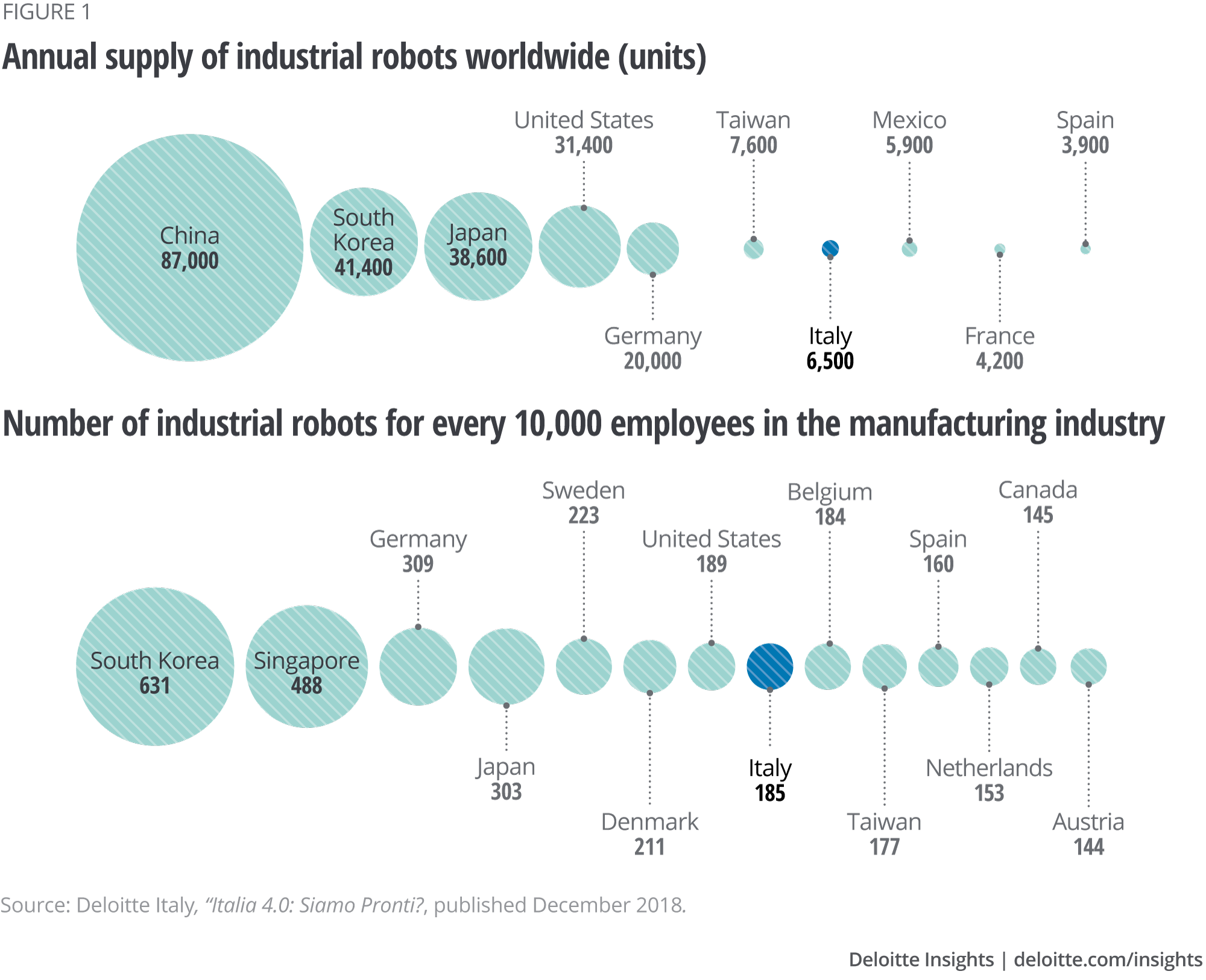
Talking machines show M2M strength
Italy ranks sixth worldwide in terms of M2M communication, which is fundamental to Industry 4.0. This technology permits the automatic, real- time exchange of data within a network of systems, machines, sensors and industrial robots. SIM cards, used in machines and sensors to permit the transmission of M2M data, number 16.4 for every 100residents: a figure equivalent to such countries as China and Germany, and ahead of Japan (12.7) and South Korea (8.3)7 (see Figure 2).
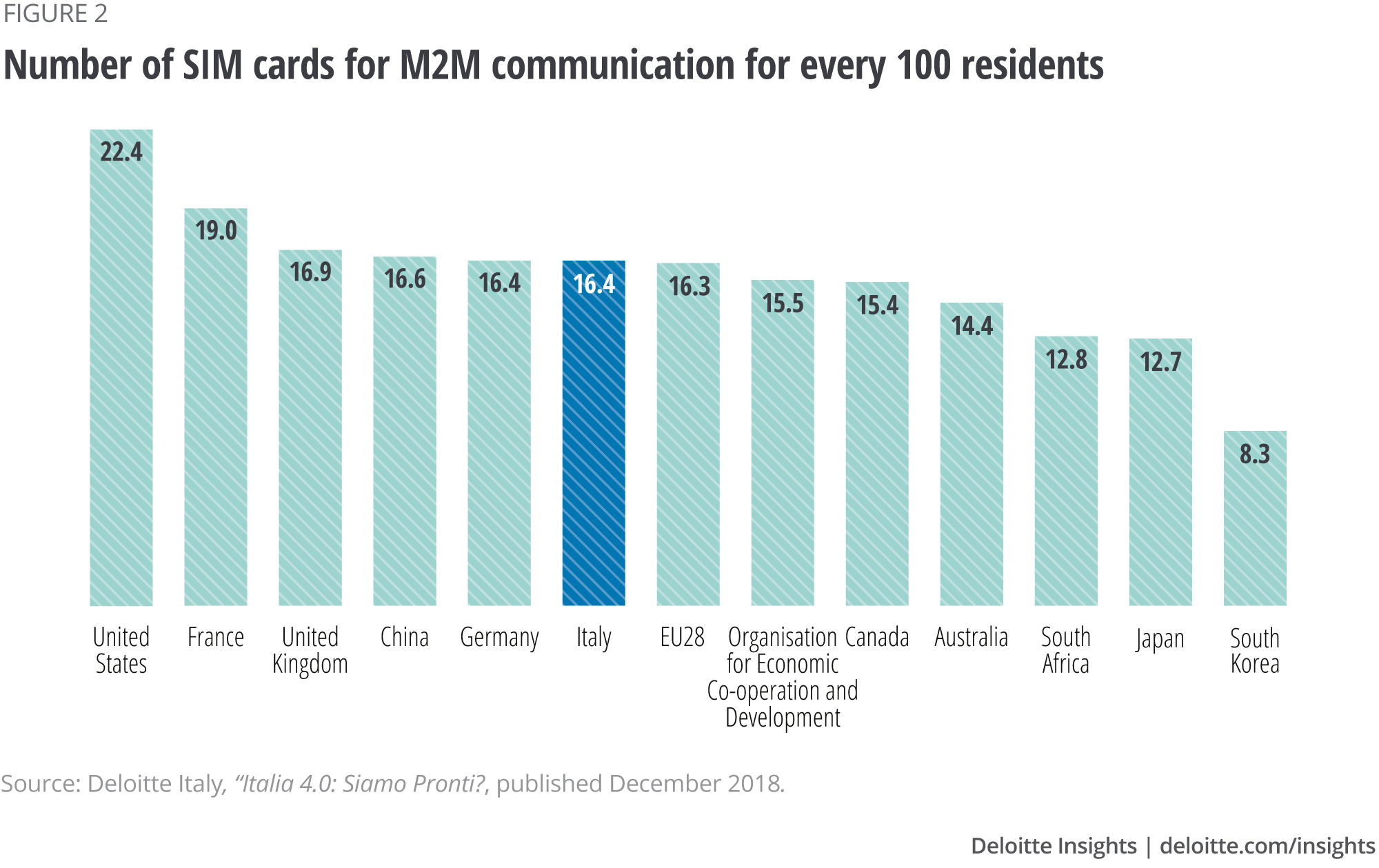
Cloud-powered advantage
Italy is also advancing promisingly in cloud computing, another technology crucial to digital innovation. Cloud computing makes it possible to implement other solutions – information management, such as big data and cognitive analytics; predictive models; artificial intelligence and machine- learning tools, to name a few.
Eurostat data shows that cloud technologies have been introduced by about 22 per cent of Italian companies (see Figure 3), slightly ahead of the European average of 21 per cent and higher than Spain (18 per cent), France (17 per cent) and Germany (16 per cent).8 According to the Polytechnic University of Milan, the cloud technologies market in Italy grew by 18 per cent in 2017, to a value of almost €2 billion, with manufacturing companies leading the way.9
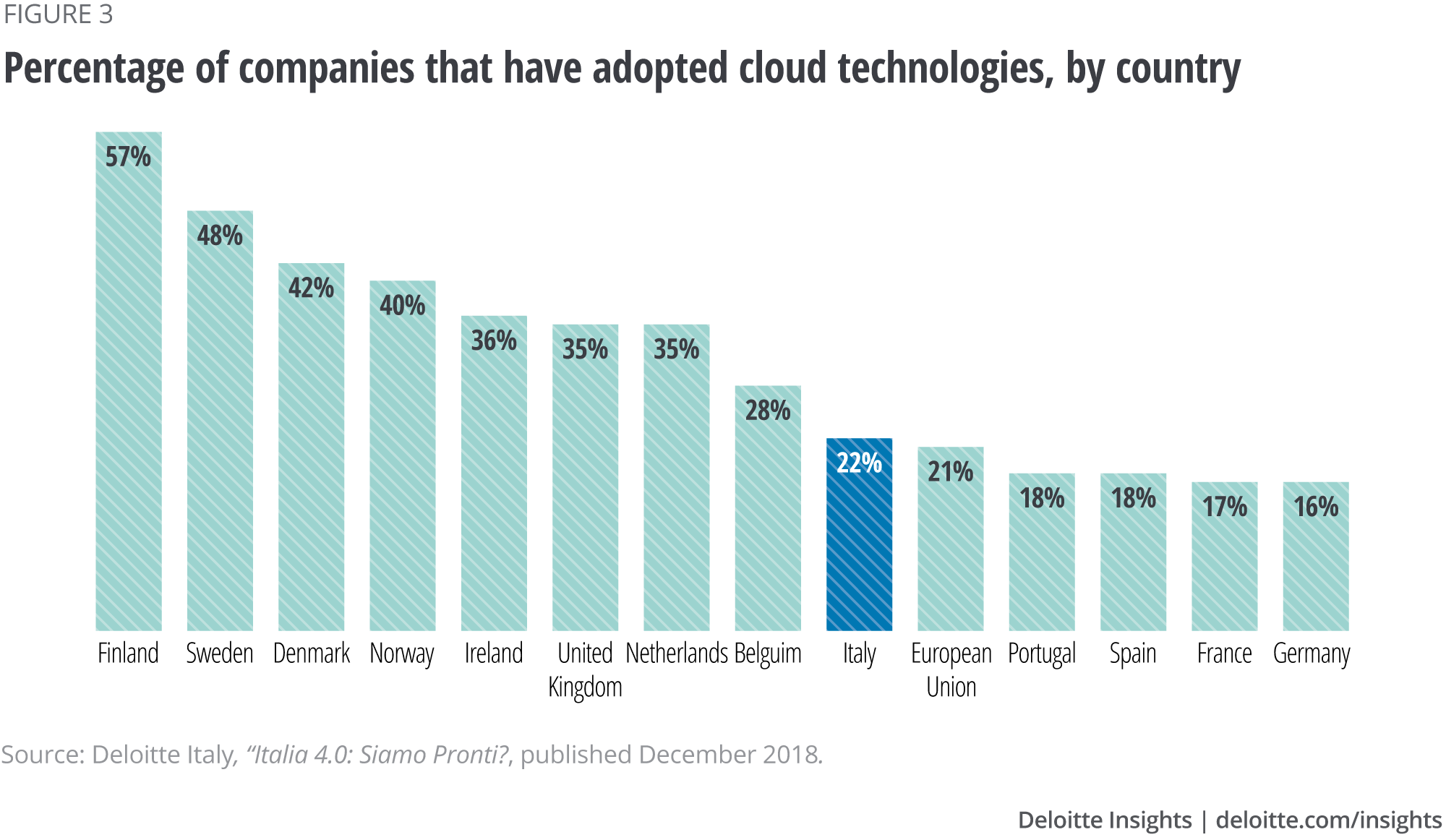
Fast-rising Internet of Things
IoT use is also rising fast in Italy. The value of the country’s IoT market in 2017 was €3.5 billion, which was 32 per cent higher than in 2016.10 In three years the sector has more than doubled. In 2017, the smart metering and smart car segments were the largest IoT sectors, with output of €980 million and €810 million, respectively, followed by smart buildings (€520 million) and IoT solutions for industrial logistics (€360 million).11
Weaknesses and mitigation
As the above findings show, Italy is, in many regards, up with the leaders in the digital revolution. But there are technical infrastructure weaknesses that need to be addressed. Moreover, digital investment by the government and the private sector is seen by some as inadequate. An additional concern is that the education system does not train enough people in advanced technologies.
Inadequate broadband
A clear and very fundamental example of a technical weakness is Italy’s poor provision of broadband. At present, only seven per cent of Italian companies have a 100 Mbps Internet connection, which is less than half the European average of 16 per cent (see Figure 4). In Denmark and Sweden, the high-speed broadband frontrunners, the percentage is as high as 42 and 39 per cent, respectively.12
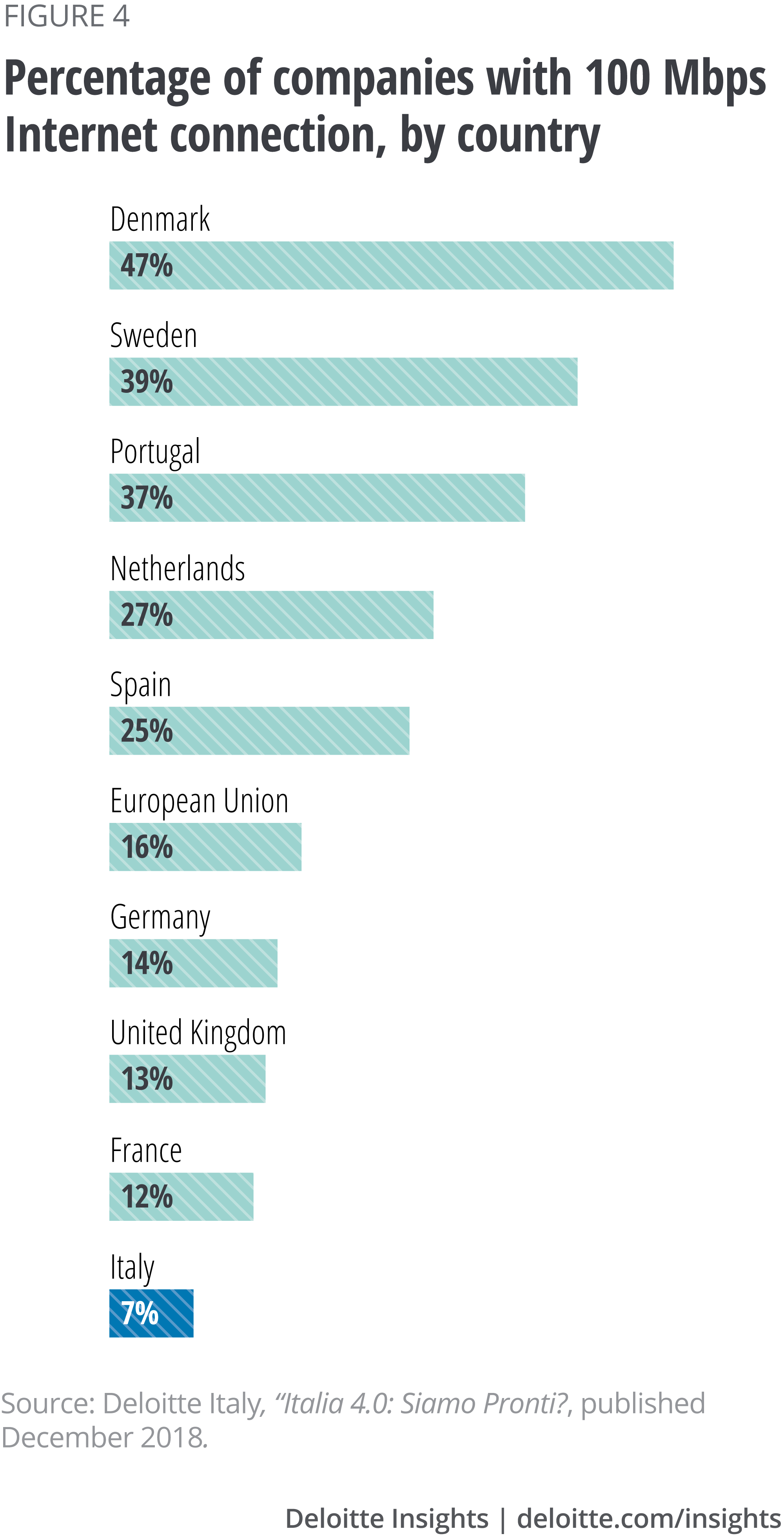
National Industry 4.0 plan targets weaknesses
In 2016, the Italian government, then with Matteo Renzi as prime minister, aimed to address some of the deficiencies with its National Industry 4.0 plan, adopted in 2017. The chief focus was enabling technologies for Industry 4.0, to which €3.5 billion was allocated and for which tax breaks (so-called super- and hyper-amortisation) were introduced to encourage investment by Italian companies. Measures were aimed at providing nationwide ‘ultra-broadband’ (access of at least 30 Mbps), defining open-source standards for M2M communication in the IoT environment and developing high-speed digital networks.13
According to ISTAT, the official Italian statistics provider, the plan stimulated corporate digital investment. In 2017, tax incentives encouraged two thirds (67 per cent) of Italian companies to invest in new technologies and machinery. However, the impact was mostly in large companies – 96.7 per cent of those with more than 50 employees made fresh investments because of tax incentives. Among smaller companies, with fewer than 50 employees, only 42 per cent did so.14
ISTAT data suggests that 62.1 per cent of manufacturing companies considered super-amortisation very or quite significant in their decision to invest. Hyper-amortisation and tax credits for R&D expenses were seen as significant by 47.6 per cent and 40.8 per cent of companies, respectively.15
Education and training deficits
The limitations of the Italian education system, in terms of skills and training related to advanced technologies, are another major concern. Italy’s robotics industry has complained that there are not enough specialised professionals and technical experts. According to the Ministry of Economy and Finance, Italy is considerably below the European average as far as its workforce having digital competence 29 per cent, as compared to 37 per cent for Europe as a whole.16
Participation in 4.0 training courses in Italy, at 8.3 per cent, is also well below the European average of 10.8 per cent. In this respect, Italy also ranks far behind France, at 18.8 per cent, and the United Kingdom, at 14.4 per cent. The gap is, unsurprisingly, even wider compared to digital leaders such as Sweden, Denmark and Finland, where more than a quarter of the workforce is educated in aspects of digital technology.17
However, in the 2018 budget Italy’s government put forward a plan to invest €10 million in 2018, and €35 million by 2020, to develop technical institutes. The goal is to train an additional 200,000 university students, 20,000 technical institute students, 3,000 managers and 1,400 PhD holders/candidates, all with a specific focus on Industry 4.0 topics.18
Executive mood
Deloitte’s 2018 global survey showed Italy to be in quite an advanced position with regard to digital technology. However, perhaps reflecting the country’s generally less-than-optimistic mood, Italian executives indicated that they feel their country lags behind. They feel much less confident than their global peers about implementing new digital technologies. They also see the likely social impact of the digital revolution as problematic, rather than beneficial.
Investment short-changing advancement
Only six per cent of Italian executives interviewed consider Italy more advanced than other European countries in the development of Industry 4.0 (Figure 5), and 37 per cent believe it is less advanced. Their unfavourable view reflects 42 per cent of executives’ belief that public investment is inadequate; 39 per cent feel the same about private investment.
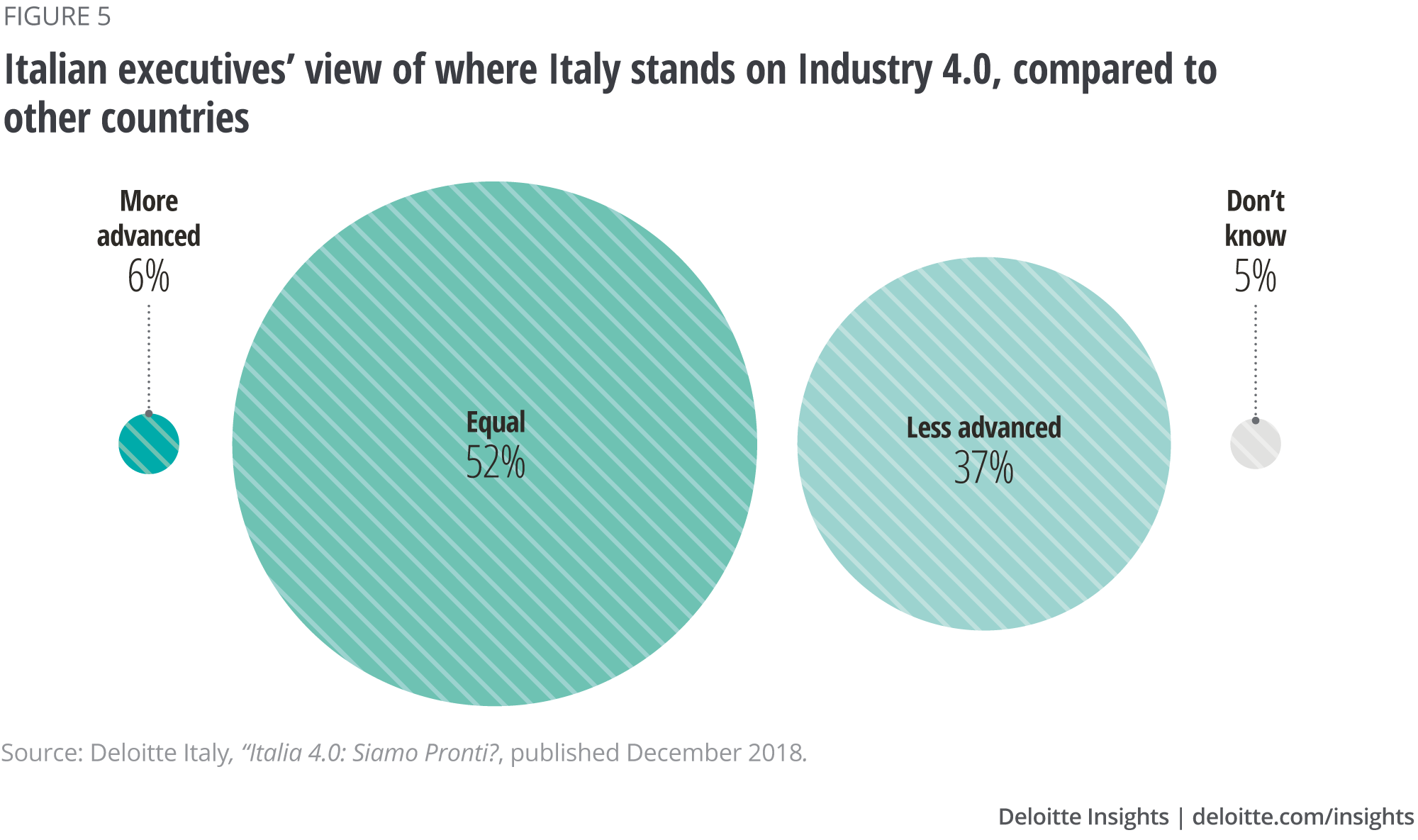
This sentiment, particularly regarding public investment, probably reflects their perception that the cash-strapped Italian government will not be able to follow through with investments the digital economy requires. More than one in three survey respondents were unconvinced by the National Industry 4.0 plan.
Trepidation in implementation
Italian executives know digitalisation is potentially transformational. Forty-nine per cent fully agreed that the advent of increasingly smart and autonomous technologies is the trend that will influence their businesses the most over the next five years. Globally, only 31 per cent hold this view.
Despite this, Italian executives are less confident than global ones about how to implement the new technologies. Only five per cent of Italian executives described themselves as ‘fully capable’ of undertaking the organisational changes required by such technologies; global executives are much more certain, with 22 per cent judging themselves ‘fully capable’.
Thus, compared to their global peers, Italian business leaders are more aware of the vital competitive opportunity presented by technological transformation but less confident about how to tackle the transformation.
Risk of superficial digitalisation
Executives’ uncertainty about implementation may have important consequences; digitalisation may not be employed to maximum transformational effect in Italian business models. Survey responses suggested that, globally, there is a much greater focus on devoting new technologies to developing human resources and new skills, when compared to Italy. Italy risks missing out on a more profound digital revolution.
Fifty-nine per cent of Italian executives said they intend to invest in new technologies related to processes and operations, and 54 per cent in digital help for customer support, such as marketing and sales. Only 38 per cent plan to invest in digitalisation for production and 37 per cent for product development. Just 18 per cent are looking to direct investments to talent management – less than half the global figure of 40 per cent.
Negative social implications
Outright pessimism emerges where the social consequences of new technologies are concerned. As Figure 6 shows, 66 per cent of Italian executives believe digitalisation will produce greater social upheaval and income inequality. The expectation of global executives as a whole is – in stark contrast – positive: 87 per cent foresee greater income equality and social stability, believing that new technologies will create more jobs than they eliminate.
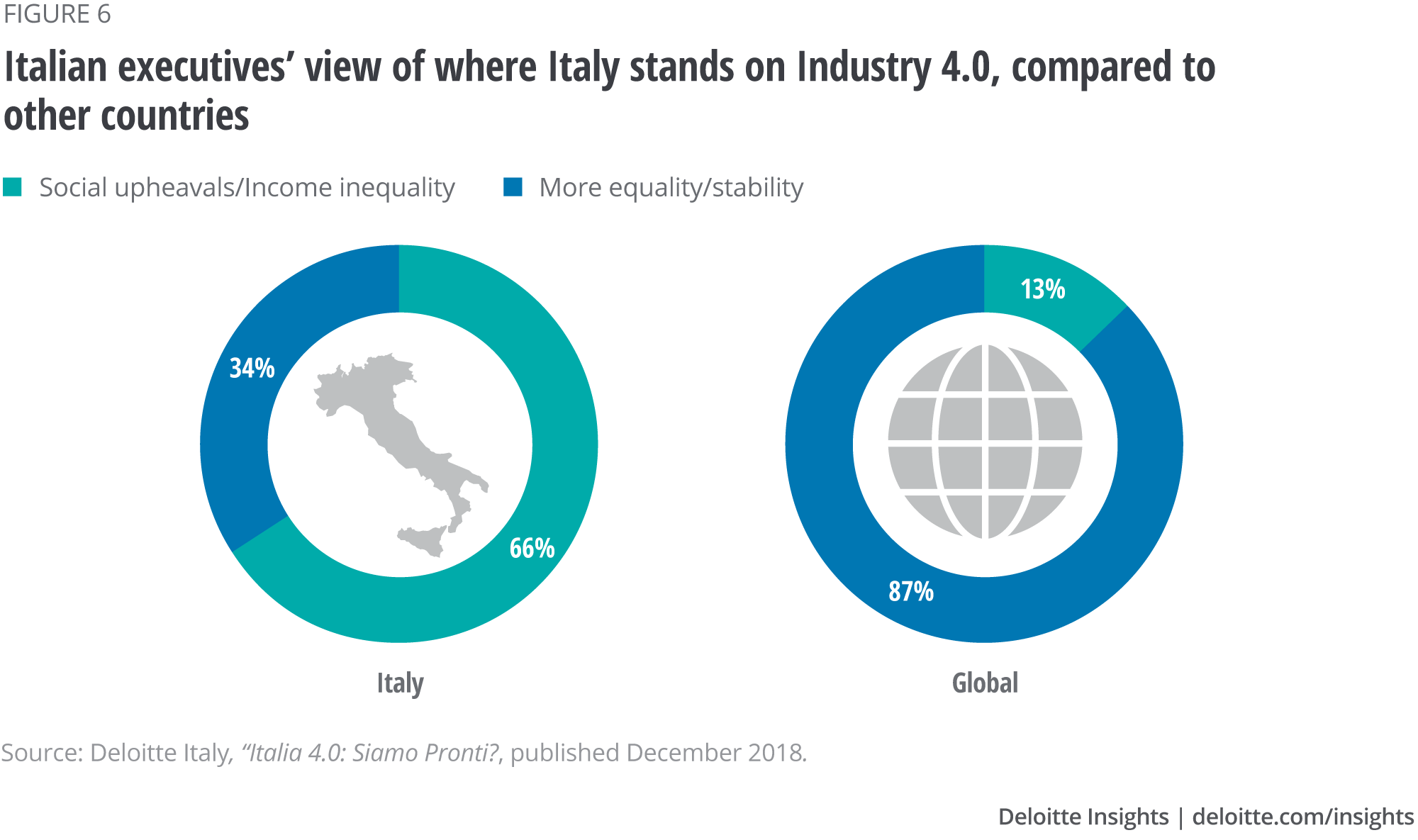
The Italians’ perspective is probably influenced by the concern that new technologies will require much different abilities and skills, which could have dramatic repercussions in the job market. They may also be influenced by the far-from-positive political and economic developments of recent years.
Macro-political backdrop
The backdrop to Italy’s digital revolution is unquestionably difficult. The country’s latest government, the sixth since 2010 and an unusual blend of the right-wing Northern League and the left-wing Five Star Movement, is at odds with the EU over its budget plans. Italy’s debt, at over 130 per cent of the gross domestic product (GDP), is the biggest in the EU after Greece’s. The yield on Italian benchmark debt, the ten-year government bond, rose in late November 2018 to around 3.2 per cent – not a high figure on a historical basis but one that compares very unfavourably with yields of only around 0.36 per cent on German and 0.7 per cent on French government bonds of the same maturity.19
The new government’s initial proposal to run a 2.4 per cent of GDP budget deficit has put financial markets and the EU on edge. (In mid-December, the Italian government lowered the proposed target to 2.04 per cent.) This deficit is not exceptionally high and, in fact, is within the EU’s Maastricht criteria.20 But Italy’s debt is substantial, and rising yields on that debt will exacerbate the government’s fiscal problems, potentially reducing the funds it has available for investment in technology.
More profoundly, the country’s economic growth record is very poor, which in turn is depressing tax revenue. The economy has grown little since 2000, and even its recovery in the past three years trails far behind that of Germany and France, and Europe as a whole. Another blow is that the recovery shows signs of fading. In the third quarter of 2018, the Italian economy contracted by 0.1 per cent, compared to the previous quarter, while most other European economies continued to grow.
Conclusion
The EU, financial markets and Italian executives are at one in their fears that Italy’s government may not be able to keep the country stable and provide the basis for a prosperous future. But the latest signs, as of December 2018, indicate that the new government is prepared to compromise; it has reduced its targeted budget deficit to 2.04 per cent of the GDP. The EU’s concerns, and those of financial markets, may be calmed, at least for a while. But unstable politics and economic anxieties have, unfortunately, become Italy’s norm.
This makes it all the more striking that the Italian economy has progressed far along the path of the Fourth Industrial Revolution. In terms of the number of high-tech companies and the use of robotics, M2M communication and the cloud, Italy represents a leading economy, not a laggard. Italian executives and observers of Italy might draw some confidence from this. Despite significant macro-political weaknesses, Italian business has managed to overachieve. In the digital era, it might prove able to continue to do so.
Explore more on Industry 4.0
-
Distinctive traits of digital frontrunners in manufacturing Article6 years ago
-
Synchronizing the digital supply network Article6 years ago
-
Embracing a digital future Article7 years ago
-
Following the digital thread Video series7 years ago








